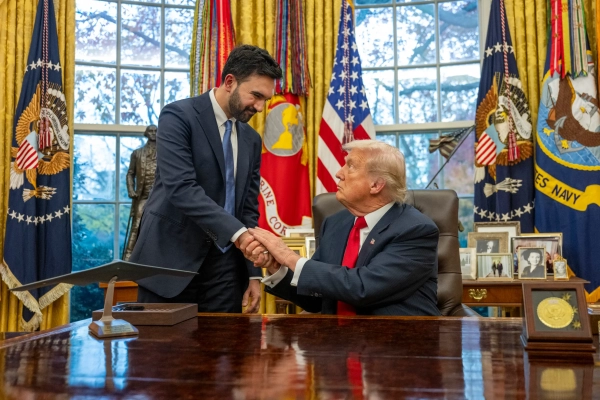At the very moment the Supreme Court appears to be moderating on voting rights, GOP judges are going after America’s most important voting rights law.

President Ronald Reagan signs a 1982 law expanding the Voting Rights Act — back when Republicans still supported such things. Getty Images Ian Millhiser is a senior correspondent at Vox, where he focuses on the Supreme Court, the Constitution, and the decline of liberal democracy in the United States. He received a JD from Duke University and is the author of two books on the Supreme Court.
The Supreme Court, after a long period of hostility toward any claim brought under the federal Voting Rights Act, recently signaled that this hostility has limits. Last June, the Court surprised nearly everyone who follows voting rights litigation by declaring Alabama’s racially gerrymandered maps illegal and ordering the state to draw a second majority-Black congressional district.
Yet if the Supreme Court’s June decision in Allen v. Milligan (2023) was supposed to be a signal that the justices intend to keep at least some safeguards against racism in elections in place, several Republican appointees to the lower courts missed the memo. Last week, as most Americans were thinking about their Thanksgiving dinners, a pair of federal appeals courts handed down some of the sharpest attacks on the Voting Rights Act — the landmark 1965 law prohibiting race discrimination in US elections — in the law’s history.
The first was an opinion from a divided panel of the United States Court of Appeals for the Eighth Circuit that, if affirmed by the Supreme Court, would virtually destroy the Voting Rights Act.
The Eighth Circuit’s opinion in Arkansas State Conference NAACP v. Arkansas Public Policy Panel, written by Trump Judge David Stras, would strip private parties of their ability to file lawsuits enforcing the Voting Rights Act and establish that all such lawsuits must be brought by the Justice Department.
This decision is dead wrong, and it conflicts with decades of precedent.
As Judge Lavenski Smith notes in dissent, over the past 40 years litigants have brought 182 successful lawsuits under the Voting Rights Act. Only 15 were brought solely by the DOJ. So, if Stras’s unusual reading of the law were correct, nearly 92 percent of all of these victorious lawsuits should have ended in defeat for the plaintiffs.
Then, on the day after Thanksgiving, the 11th Circuit handed down its own decision attacking a core principle of the Voting Rights Act. Trump Judge Elizabeth Branch’s opinion in Rose v. Secretary isn’t quite as aggressive as Stras’s wholesale attack on the landmark law — while Stras’s opinion could potentially neutralize the Voting Rights Act in its entirety, Branch’s opinion would only permit states to use one particular method that has historically been used to disenfranchise voters of color.
Specifically, Rose asks whether states may elect multi-member bodies such as a legislature using an “at-large” scheme where every member of the body is elected by the state as a whole. As the Supreme Court warned in Rogers v. Lodge (1982), “at-large voting schemes and multimember districts tend to minimize the voting strength of minority groups by permitting the political majority to elect all representatives of the district.” Thus, in a state like Georgia, where white people make up nearly 60 percent of the population, white voters can join together to prevent the Black minority from electing anyone to a state board if the state uses an at-large system to elect those board members.
Nevertheless, Branch’s decision in Rose would make it extraordinarily simple for states to use at-large systems that could not be challenged in court — even though both the Supreme Court and lower federal courts have repeatedly permitted challenges to at-large systems that lock racial minority groups out of power. Branch’s opinion even lists nearly a dozen cases challenging such at-large systems.
These decisions, both by Trump judges, should alarm anyone who cares about voting rights. While the Court’s decision in Milligan suggests that, at the very least, Stras’s attempt to nuke the Voting Rights Act is likely to be reversed by the current panel of justices, judges like Stras and Branch are hardly outliers among the right-wing advocates and Federalist Society stalwarts that Trump appointed. If anything, their records suggest they are right in the heartland of modern-day Republican appointees to the federal bench.
And that means that, even if this Supreme Court resists these new efforts to destroy the one federal law that likely did more than any other to end Jim Crow, there is a serious risk that the entire law could fall if Republicans — such as Trump himself — get to appoint more judges to the Supreme Court.
Stras’s opinion is a trainwreck
The specific question in the Arkansas case is whether Section 2 of the Voting Rights Act, the provision that allows lawsuits challenging racially discriminatory voting practices by states, may be enforced by private parties or if these lawsuits may only be brought by the Justice Department. For decades, courts — including the Supreme Court — have allowed private parties to bring such suits.
And, as Judge Smith wrote in his dissent, 167 of these private plaintiffs have brought successful lawsuits under Section 2, including the plaintiffs in the Milligan case.
To understand why Stras’s opinion departing from this longstanding consensus is wrong, it’s helpful to understand the Supreme Court’s decisions governing what are known as “implied rights of action.”
Sometimes, federal laws contain language explicitly stating that private parties have a “right of action” (meaning a right to sue) against certain defendants. Other times, a legal document may explicitly state that private parties may not file certain lawsuits. It is common, for example, for presidential executive orders to contain language stating that the order does not “create any right or benefit” which can be enforced in federal court.
But what if a law does not state either way whether it permits private parties to bring lawsuits to enforce that law? In short, the answer to this question has changed over time. In J.I. Case v. Borak (1964), decided the year before the Voting Rights Act became law, the Supreme Court held that courts should read federal statutes generously to allow the parties who benefit from those laws to bring federal lawsuits.
“It is the duty of the courts,” the Supreme Court held in Borak, “to be alert to provide such remedies as are necessary to make effective the congressional purpose.” The Supreme Court explained a few years later, in a Voting Rights Act case, that “a federal statute passed to protect a class of citizens, although not specifically authorizing members of the protected class to institute suit, nevertheless implied a private right of action.”
So under the rules that existed when the Voting Rights Act was written in 1965, it clearly should be read to permit private lawsuits.
That said, post-1965 decisions, handed down by more conservative courts, have held that the judiciary should be more reluctant to find implied rights of action within a federal statute than the Court was in Borak. The most significant of these decisions is probably Alexander v. Sandoval (2001), which held that “statutes that focus on the person regulated rather than the individuals protected create ‘no implication of an intent to confer rights on a particular class of persons.’”
So, under Sandoval, if a federal law uses language like “no state shall do X” instead of “all persons have a right to X,” courts typically should not permit private lawsuits under that statute.
The thrust of Stras’s opinion in the Arkansas case is that Sandoval should be read retroactively to neutralize the right of private parties to sue under the Voting Rights Act. This decision is fundamentally unfair to Congress, as Sandoval was handed down nearly four decades after the Voting Rights Act became law. So Congress couldn’t possibly have known that it had to write the law in a particular way if it wanted to authorize private lawsuits.
It’s also not entirely clear that Sandoval cuts off private suits under the Voting Rights Act, even if it is applied retroactively. Recall that the inquiry under Sandoval hinges on whether a statute refers to the entity it seeks to regulate, rather than the “individuals protected” by that statute. But the Voting Rights Act uses both kinds of language.
While the relevant provision starts with the phrase “no voting qualification or prerequisite to voting or standard, practice, or procedure shall be imposed or applied by any State,” it goes on to forbid any voting practice “which results in a denial or abridgement of the right of any citizen of the United States to vote.”
Sandoval, moreover, also states that “the judicial task is to interpret the statute Congress has passed to determine whether it displays an intent to create not just a private right but also a private remedy,” and that “statutory intent on this latter point is determinative.” And there is overwhelming evidence that Congress intended to create a private right of action when it wrote the Voting Rights Act.
Again, Congress wrote the law against the backdrop of decisions like Borak, which emphasized that private parties should generally be allowed to sue to enforce their legal rights. Federal courts have understood the law to permit private suits at least as far back as the 1960s. And Congress has amended the VRA multiple times, but it’s never questioned the longstanding assumption that the law permits private lawsuits.
Federal civil rights law also includes a catch-all statute, known as “Section 1983,” which permits state officials to be sued if they deprive someone of “any rights, privileges, or immunities secured by the Constitution and laws.”
The Voting Rights Act law secures a right to be free from race discrimination in elections. That means that, even if the Voting Rights Act itself doesn’t authorize a private cause of action, Section 1983 permits lawsuits seeking to enforce the rights created by the Voting Rights Act. Indeed, the Supreme Court just reaffirmed in Health and Hospital Corporation v. Talevski (2023) that Section 1983 gives private individuals broad authority to sue to enforce their statutory rights.
Stras’s approach, in other words, isn’t simply wrong, it is obviously wrong. And his Arkansas opinion will lead to disastrous results if it is not reversed. As the Supreme Court warned in Allen v. State Board of Elections (1969), the Voting Rights Act “could be severely hampered … if each citizen were required to depend solely on litigation instituted at the discretion of the Attorney General.” Among other things, “the Attorney General has a limited staff and often might be unable to uncover quickly” new state policies that target voters of color.
In fact, Stras’s approach would likely shut down the Voting Rights Act almost in its entirety whenever Republicans control the White House. During the entire Trump administration, the Justice Department’s voting section brought only one lawsuit alleging discrimination under the Voting Rights Act — and that was a fairly minor suit alleging that the method of electing school board members in a South Dakota school district “dilutes the voting strength of American Indian citizens.”
Branch’s opinion is also a trainwreck
The one good thing that can be said about Judge Branch’s opinion in Rose is that, unlike Stras’s Arkansas opinion, it doesn’t attempt to destroy the Voting Rights Act almost in its entirety. But the Rose opinion is still wrong, and it betrays a hostility toward federal voting rights that raises serious questions about whether the three judges who decided the Rose case have any familiarity with American civil rights history.
As noted above, courts fairly frequently hear, and sometimes strike down, at-large voting systems because of their impact on voters of color. While such systems are not always illegal, they run afoul of the Voting Rights Act when, in the words of the statute, an at-large system “results in a denial or abridgement of the right of any citizen of the United States to vote on account of race or color.”
Branch’s opinion, however, would likely greenlight such systems whenever they are used on a statewide basis, rather than by a county, municipality, or other, smaller governmental body. Though Branch acknowledges many decisions where courts have struck down at-large systems used by city councils, school boards, and the like, she claims that Voting Rights Act lawsuits have “never been used to invalidate a statewide election system on vote dilution grounds.”
That may well be true, but it is a meaningless distinction. The Voting Rights Act’s text applies equally to “any State” as well as any “political subdivision” of a state. So the statute applies with equal force both to statewide practices that violate the law and to similar practices by city councils or other smaller bodies. Branch’s opinion is entirely at odds with the law’s text.
To this, Branch replies that “general principles of federalism” require her to uphold the state of Georgia’s practice of electing all five members of its Public Service Commission on an at-large basis — “federalism” refers to the idea that states retain some degree of sovereignty that cannot be taken from them by a federal law.
But the concept of states rights, as anyone who has even the most basic understanding of American civil rights history will understand, has no place whatsoever in a Voting Rights Act lawsuit. The entire purpose of the Voting Rights Act was to prevent Jim Crow states, including Georgia, from running their elections in ways that depart from the federal commitment to racial equality.
The Constitution, moreover, is quite clear that Congress — and not the state of Georgia — has the final say on how elections will be conducted in that state, at least when race discrimination is an issue. The 15th Amendment prohibits states from denying or abridging the right to vote “on account of race, color, or previous condition of servitude,” and it provides that “Congress shall have the power to enforce this article by appropriate legislation.”
To justify her decision, Branch relies heavily on the 11th Circuit’s decision in Nipper v. Smith (1994), a Voting Rights Act case that challenged Florida’s practice of having all of the voters within a given judicial circuit elect the judges in that circuit — that is, on an at-large basis. The plaintiffs in Nipper argued that these judicial circuits should be chopped up into sub-districts, with each sub-district electing a subset of the circuit’s judges.
But Nipper rejected this solution in no small part because it would have undermined the Voting Rights Act’s goal of fostering racial equality. If Florida judges were elected by sub-districts, the court warned, that would mean that judges in majority-Black sub-districts would be chosen by Black voters, but judges in majority-white sub-districts would be chosen by white voters. This system, the court feared, would be “detrimental to … fair and impartial justice” because all of these judges would continue to have jurisdiction over the entire circuit — and thus judges elected solely by white voters would continue to hold authority over Black litigants.
Nipper, in other words, rejected a cure that was worse than the disease. It held that federal courts should not break up an at-large system of electing judges if the solution would lead to more judges being elected by insular white majorities who may very well be hostile to the interests of Black voters. That’s a far cry from Branch’s claim that vague appeals to “federalism” justify weakening a statute whose entire purpose is to strip states of some of their authority over election administration.
Moreover, while Branch’s opinion, on its face, is limited to Voting Rights Act challenges to statewide at-large systems, her freewheeling appeal to “federalism” has serious implications for all kinds of voting rights lawsuits by suggesting that states have some ill-defined right to resist voting rights legislation that school boards or city councils do not.
So what should we make of these two decisions?
If Arkansas and Rose had been handed down a year ago, they would have seemed like an effort by lower courts to move in the same direction the Supreme Court has been moving for several years.
Prior to Milligan, the Roberts Court’s record in Voting Rights Act cases was almost unrelentingly hostile. In Shelby County v. Holder (2013), the Court’s Republican appointees simply made up a doctrine — “the principle that all States enjoy equal sovereignty” — that is never once mentioned in the Constitution in order to justify striking down a key provision of the Voting Rights Act. In Brnovich v. DNC (2021), the Supreme Court similarly made up a bunch of limits on the Voting Rights Act that cannot be found anywhere in any legal text, such as a strong presumption that voting restrictions that were in place in 1982 are lawful.
Faced with these precedents — decisions that, in Justice Elena Kagan’s words, “mostly inhabit[ ] a law-free zone” — Stras’s and Branch’s disregard for longstanding law might be understandable. After all, the Roberts Court frequently hands down Voting Rights Act decisions that do not even attempt to ground their holding in constitutional or statutory text.
But Milligan suggests that the Supreme Court may be moving away from this hostility. Unlike Shelby County and Brnovich, Milligan hewed closely to longstanding law. As the Court said in Milligan when it affirmed a lower court decision striking down Alabama’s gerrymandered maps, that decision “faithfully applied our precedents.”
At the very least, Stras’s and Branch’s opinions are likely to force the Supreme Court to resolve this tension between Milligan and its previous, less justifiable decisions undercutting the Voting Rights Act. Neither lower court judge’s decision is persuasive. But they are entirely consistent with the law-free zone the Supreme Court seemed to erect around the Voting Rights Act in cases like Shelby County and Brnovich.
Sourse: vox.com






